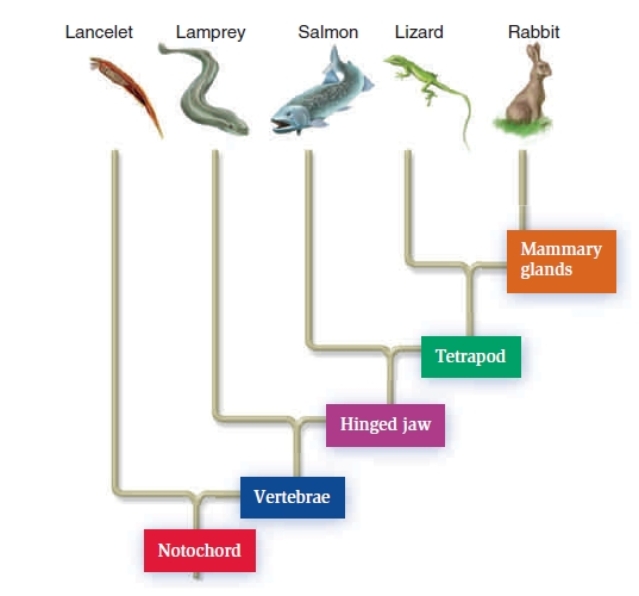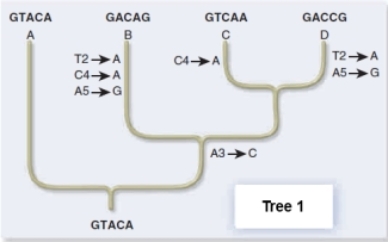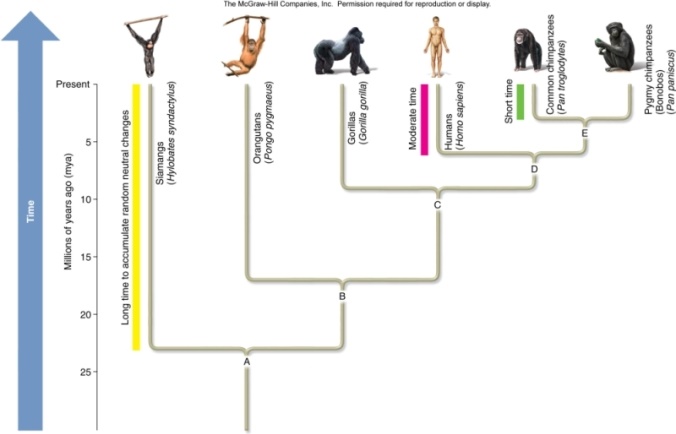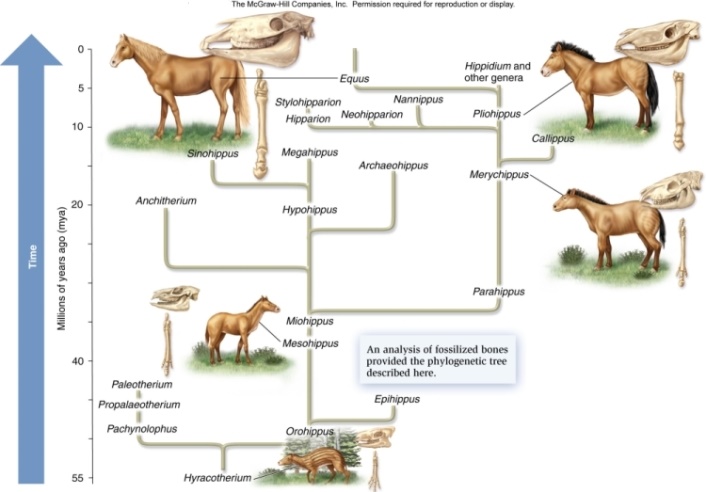A) nomenclature.
B) taxonomy.
C) ecology.
D) systematics.
E) biology.
Correct Answer

verified
Correct Answer
verified
Multiple Choice
Refer to the cladogram below.Which shared derived character is common to the lizard and rabbit but not the salmon? 
A) Notochord.
B) Vertebrae.
C) Tetrapod locomotion.
D) Mammary glands.
Correct Answer

verified
Correct Answer
verified
Multiple Choice
Use the principle of parsimony and molecular genetic data to choose a phylogenetic tree for your hypothesis of how the extant species were derived from the ancestor. 

A) Tree 1 requires the most mutations,making it the best choice.
B) Tree 1 requires the fewest mutations,making it the best choice.
C) Tree 2 requires the most mutations,making it the best choice.
D) Tree 2 requires the fewest mutations,making it the best choice.
E) Both trees are equally good because sequences A,B,C,and D are the same in both.
Correct Answer

verified
Correct Answer
verified
Multiple Choice
__________ is a term that refers to similarities among various species that occur because the species are derived from a common ancestor.
A) Analogy
B) Phylogeny
C) Homology
D) Heterology
E) Morphology
Correct Answer

verified
Correct Answer
verified
Multiple Choice
Horizontal gene transfer is less prevalent in eukaryotic species because
A) of the presence of organelles in the cells of eukaryotic species.
B) of the multicellularity in eukaryotic species,which is lacking in prokaryotic species.
C) eukaryotic species reproduce by sexual reproduction.
D) of multicellularity and sexual reproduction.
E) of the presence of organelles and multicellularity.
Correct Answer

verified
Correct Answer
verified
Multiple Choice
The firefly (Photinus granulatus) and the zebra mussel (Dreissena polymorpha) are both members of the kingdom Animalia.This indicates that they must also both be members of the same
A) species
B) genus
C) order
D) phylum
E) domain
Correct Answer

verified
Correct Answer
verified
True/False
An assumption for the use of molecular clocks is that neutral mutations accumulate at a rapidly increasing rate over time between two species.
Correct Answer

verified
Correct Answer
verified
Multiple Choice
Members of the plant family Cactaceae (cacti) are native to the Americas and thrive in dry environments.They have a number of specialized adaptations,including reduced leaves,succulent (fleshy) stems for water storage,and spines for defense against herbivores.Some members of the family Euphorbiaceae are native to Africa and resemble cacti,having similarly reduced leaves,succulent stems,and thorns.However,their common ancestor likely did not have these traits.Based on this information,what can you say about the morphological traits of Cactaceae and Euphorbiaceae indicated above?
A) They are shared primitive traits.
B) They are shared derived traits.
C) They are homologous traits.
D) They are analogous traits.
Correct Answer

verified
Correct Answer
verified
Multiple Choice
Molecular clocks are based primarily on rates of
A) neutral mutations.
B) favorable mutations.
C) detrimental mutations.
D) natural selection.
E) horizontal gene transfer.
Correct Answer

verified
A
Correct Answer
verified
Multiple Choice
Which of the following is NOT a principle used when constructing cladograms?
A) All species or higher taxa are placed on tips in a phylogenetic tree.
B) All species or higher taxa are placed on nodes in a phylogenetic tree.
C) Each cladogram branch point should have one or more shared derived characters that are common to all species above the branch point,unless the character is later modified.
D) All shared derived characters appear together only once in a cladogram unless they arose independently during evolution more than once.
Correct Answer

verified
Correct Answer
verified
Multiple Choice
A phylogenetic tree is a diagram that describes a phylogeny.A phylogeny is
A) the evolutionary history of a species or group of species.
B) the geographic distribution of populations in a species.
C) the generations of individuals in a population.
D) the distribution of species in a given area in time.
E) a list of character traits of individual species set in a tree diagram.
Correct Answer

verified
Correct Answer
verified
Multiple Choice
The science of describing,naming,and classifying extant and extinct organisms is
A) evolution.
B) phylogeny.
C) taxonomy.
D) nomenclature.
E) biology.
Correct Answer

verified
Correct Answer
verified
Multiple Choice
The figure shows a simplified phylogeny of closely related species of primates.This tree was proposed by comparing DNA sequence changes in the gene for cytochrome oxidase subunit II.The vertical scale represents time and the branch points represent common ancestors.What species did ancestor B give rise to? 
A) Siamangs and orangutans.
B) All of the species except orangutans.
C) All of the species except siamangs.
D) All of the species except siamangs and pigmy chimps.
E) Gorillas,humans,and both types of chimps.
Correct Answer

verified
Correct Answer
verified
Multiple Choice
The mitochondrial genome would be most useful for studying evolutionary relationships among which group of organisms?
A) whales (members of the order Cetacea)
B) animals (members of the kingdom Animalia)
C) plants (members of the kingdom Plantae)
D) eukaryotes (members of the domain Eukarya)
E) all organisms (members of domains Bacteria,Archaea,and Eukarya)
Correct Answer

verified
A
Correct Answer
verified
Multiple Choice
This tree is based on which type of traits and what is the genus name for the most recent horse? 
A) Genetic (DNA) : Orohippus.
B) Morphological: Equus.
C) Molecular: Equus.
D) Genetic homology: Pliohippus.
E) Morphological: Hyracotherium.
Correct Answer

verified
Correct Answer
verified
Multiple Choice
Which of the following organisms would NOT be classified in the Domain Eukarya?
A) Canis lupis (wolf) .
B) Loxodonta cyclotis (forest elephant) .
C) Salmonella enterica (bacteria that causes food poisoning) .
D) Aleuria aurantia (ascomycete fungi) .
E) Sequoiadendron giganteum (Giant Sequoia tree) .
Correct Answer

verified
Correct Answer
verified
Multiple Choice
Horizontal gene transfer is the transfer of genes between
A) two chromosomes in a nucleus.
B) organelles within a cell.
C) cells within a multicellular organism.
D) different species,both prokaryotic or eukaryotic.
E) prokaryotic species to different prokaryotic species.
Correct Answer

verified
Correct Answer
verified
Multiple Choice
Molecular clocks are usually calibrated based on
A) guesses about the rates of mutations in a particular gene.
B) observed rates of mutation in a particular gene.
C) the first shared common ancestor for species known from the fossil record.
D) comparing the gene to similar genes in other kingdoms.
E) the date when two species diverged from a common ancestor.
Correct Answer

verified
Correct Answer
verified
Multiple Choice
When choosing among competing cladograms,the preferred hypothesis is the one that is the simplest for all characters and their states.This is also known as
A) the maximum likelihood approach.
B) the principle of parsimony.
C) the Bayesian method.
D) the molecular clock.
E) the cladistic approach.
Correct Answer

verified
B
Correct Answer
verified
Multiple Choice
The idea that most of the genetic variation found in populations is not subject to natural selection is the basis of:
A) the principle of parsimony
B) the neutral theory of evolution
C) the maximum likelihood approach
D) cladistics
E) systematics
Correct Answer

verified
Correct Answer
verified
Showing 1 - 20 of 38
Related Exams